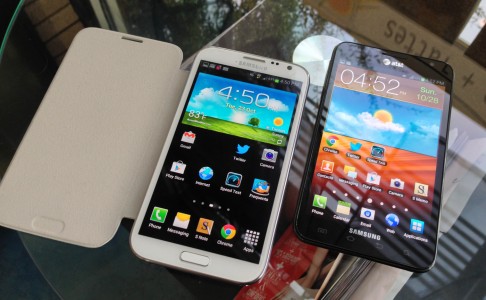Oversized smartphones are quickly becoming the must-have device for mobile users and it looks as though the ‘phablet’ trend will continue throughout 2013, proving that bigger really is better.
ABI Research has revealed the phablet – a hybrid of a phone and a tablet, boasting a display of 5-inches and larger – has come in to its own over the past year. Almost 83million phablets were shipped during 2012, a figure which is predicted to double during 2013.
The first phablet to be released was the Dell Streak back in 2010, but its 5-inch screen failed to win over fans of pocket-friendly handsets with much smaller 3-inch displays.
Fast forward a few years and more users have come to rely on their handsets for all manner of things, such as watching HD videos, regularly viewing digital content or working on the go. It is this demand that has seen smartphone displays gradually getting bigger and bigger.
Samsung was next to embrace the concept of the phablet and it was its 5.3-inch Galaxy Note that really helped propel oversized smartphones into the limelight.
Despite its impressive spec sheet critics still weren’t convinced the Galaxy Note was enough to elevate the phablet above gimmick status, but Samsung was quick to prove the tech world wrong and to date, more than 10million Galaxy Note devices have been sold.
However, it wasn’t until Samsung released the Galaxy Note 2 last year that the phablet really started to come into its own, and other smartphone manufacturers began trying to replicate the success enjoyed by the Korean firm. The growth of the oversized smartphone market looks set to continue throughout 2013 with industry experts already labelling it ‘the year of the phablet’.

During the world’s biggest consumer electronics tradeshow, CES 2013, a slew of phablet devices were unveiled, including the Sony Xperia Z, Huawei Ascend Mate and Lenovo K900, with Apple and LG also expected to bring new phablet inspired wares to the table over the next 12 months.
But, while it seems smartphone displays will only continue to grow in size there’s concern that the boundaries between phones and tablets are becoming increasingly blurred, and the once pocket-friendly smartphones you could use with one hand could soon be a thing of the past.
That said, the tablet market shows no sign of slowing down and the future of large screens may in fact lie in other form-factors, for instance flexible displays, which would provide users with the same ample screen but without the large, bulky phablet frame.
Once again Samsung is one step ahead, announcing at CES 2013 it was already working on flexible display technology. While it may take a while to bring this technology to the market, it’s good to see the Korean firm is once again paving the way for future innovations.
It seems that Samsung isn’t the only one looking to develop the ‘ultimate’ smartphone either, with BlackBerry CEO Thorsten Heins recently revealing that soon there will be no need for tablets and laptops because smartphones will be capable of doing everything.
Only time will tell which direction the concept of the phablet will go in next, but 2013 looks to be a great year for oversized smartphones, with Samsung expected to lead the way with the rumoured Galaxy Note III.
It will certainly be interesting to see if any other manufacturers can break the monopoly already achieved by Samsung in this niche, but let’s just hope those users who aren’t yet accustomed to these mammoth devices aren’t forgotten amidst all the hype.
Written by Sarah Hazelwood of Dialaphone, the home of all the latest mobiles.